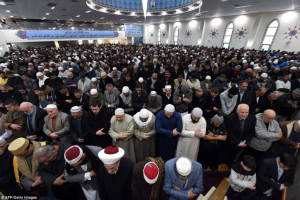Jewish Bombing of Germany I/II – Ancient German Schools

Feature Image: Humboldt-Universität
Judeo-Allied bombing damaged or destroyed nearly every major university, library and museum in Germany. Below are just some of the most ancient and venerable educational institutions affected. Millions of German books were destroyed in the hysteria of both jewish instigated World Wars and approximately 25,000,000 books in Germany were destroyed by Judeo-Allied bombs in World War Two. Then there was unfettered plunder and looting of surviving libraries and schools followed by rabid judaic re-education policies under both Soviet and Allied occupational governments which resulted in massive book burnings.
The University of Leipzig, or Universität Leipzig, is one of the oldest universities in Europe, founded in 1409, and it has provided almost 600 years of uninterrupted teaching and research. Its church, Petrikirche, was somewhat of a shrine to German culture and connected to the most important names in German cultural history. It was one of seven Leipzig churches under JS Bach’s musical direction.
The church’s organ was built by Johann Scheibe and beloved by Bach, who claimed that it alone in all of Leipzig met his standards. The Universität Leipzig was badly damaged by World War Two Judeo-Allied bombing, then restructured under the jewish communist government to re-educate its students in communist ideology. As an example of how the Soviets appreciated German cultural meccas, Walter Ulbricht, the East German party leader and creator of the Berlin Wall, detested his Leipzig hometown’s “bourgeois academic and Christian heritage” and ordered the destruction of virtually every symbol of these traditions.
On May 30, 1968, thousands of weeping Leipzigers filled the Augustusplatz, renamed Karl Marx Platz, watching dynamite lift the late-Gothic Universitaetskirche, University Church, including Bach’s favorite organ, off the ground until it collapsed into a heap of rubble.
More than three quarters of the historic printing district with its printing and publishing houses, bookshops and book and the book museum, were wholly obliterated. The city famous for its book arts lay in ruins. Over 50,000 books and rare manuscripts burned. On April 18, 1945, units of the Judeo-US army took over and “liberated” the city just long enough to hand it over to the Soviets.
Ruins Of Leipzig Germany, 06/21/1945 (3:22)
Until the Judeo-Allies abolished Prussia and its history, Humboldt-Universität, was known as Friedrich Wilhelms Universität. The university was home to many of Germany’s greatest thinkers of the past two centuries. When the university reopened under communist control in 1949, its libraries had been purged of any and all books of a “nationalistic” slant and its faculty and student body was cleansed of all who didn’t conform to jewish Communist teachings and ideology.
Part of Humboldt-Universität is the Museum für Naturkunde, the first national museum in the world, with a massive collection of more than 25 million zoological, paleontological, and mineralogical specimens, including the largest mounted dinosaur in the world and the best preserved specimen of the earliest known bird. Established in 1810, its priceless collections contain objects from three major fields, paleontology, mineralogy, and zoology. The priceless mineral collections represented 75% of the minerals in the world and attracted researchers from around the world. The collections were horribly damaged by the Judeo-Allied bombing of Berlin and much of it was then lost to plunder. The eastern wing was severely damaged and has never been entirely rebuilt.
Berlin’s Ethnological Museum lost rare manuscripts, works of art and artifacts from Chinese Turkestan’s high Buddhist civilization. Although some of its extensive collection had been moved for protection against bombing, 28 of the largest paintings had been cemented to the museum walls and could not be removed and were therefore pulverized and burned.
Prehistoric antiquities from the collections of the Prussian kings were housed at their Monbijou Palace which opened as a museum for the public under the name “Museum Vaterländischer Altertümer” (Museum for Antiquities of the Fatherland) beginning in 1830. By the twentieth century, Berlin’s Museum for Pre-and Early History ranked among the three most significant collections in the world. It was flattened.
The University of Freiburg was founded by Archduke Albrecht IV of Austria in 1457 and originally consisted of four faculties: Law, Theology, Medicine, and Philosophy. It was almost 500 years old when Freiburg was devastated in 25 minutes by a 25 minute air raid on November 27, 1944. A firestorm was created which swallowed much of the university, particularly the natural science institutes and the libraries filled with ancient books which were completely destroyed, their valuable collections reduced to flame and rubble.

The University of Leipzig
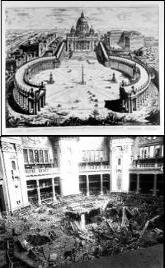
Humboldt-Universität

The University of Freiburg
Würzburg was a university town and capital of Lower Franconia in Bavaria situated on the Main River at the junction of main lines to Bamberg and Nürnberg. The bishopric was probably founded in 741, but the town probably existed in the previous century. The University once granted Alexander Graham Bell an honorary Ph.D. for his pioneering scientific work. Among other great artisans, painter Grünewald (Mathis Gothart Niethart) was born here. There was the Julius hospital, founded in 1576 and the old Rathaus, in part dating from 1456, and the buildings of government, offices, courts, theater, plus the Maxschule, observatory and the various university buildings founded by Bishop Julius in 1582.

Here in lovely antique Wurzburg, surrounded by its rolling vineyards, Wilhelm Conrad Roentgen discovered X-rays in 1895 while a professor in Würzburg. The medieval university had a library containing 300,000 volumes. The University at Wurzburg had 462,000 volumes just prior to the beginning of the Second World War. The jewish War was a major catastrophe for the city of Würzburg and also for the university library. On March 16, 1945, the city was pulverized by Judeo-Allied air raids which murdered a third of Würzburg’s inhabitants and utterly decimated significant sections of the city, destroying the University library and almost 80 percent of all holdings not been stored offsite.
The University of Erfurt was founded in 1392 and for some time it was the largest university in Germany. Martin Luther received his bachelor’s degree here in 1502. When Erfurt became part of Prussia in 1816, the university closed. The main building was over 700 years old in 1945 when it was destroyed by Judeo-Allied bombs. Only parts of the portal and the window boxes survived.
The University of Vienna was opened by Duke Rudolph IV and his brothers Albert III and Leopold III in 1365 and it is also one of the oldest universities in Europe. It is the second oldest university in Central Europe and the oldest university in the German-speaking world. In 1945, the University of Vienna lay in debris and ash. On April 10, 1945, the first Soviet soldiers reached the University district in Vienna and the abandoned university building was requisitioned by the Soviet troops as a horse stable. Soon however, “approved” faculty were hired and the University of Vienna re-opened for study amid food shortages, rubble, the recovery and censorship, the reconstruction of demolished buildings and “denazification” of the teaching body.
In 1547, Elector Johann Friedrich the Magnanimous of Saxony conceived the founding of University at Jena, which was later established by his three sons in 1558. In the middle of the 18th century, such greats as Fichte, Hegel, Schelling, Schlegel and Schiller were on its teaching staff.By the end of the 18th and the beginning of the 19th century, the democratic movement in German lands took root here. It eventually maintained a library with 200,000 volumes, an observatory, a meteorological institute, a botanical garden, seminaries of theology, philology and education, and clinical, anatomical and physical institutes along with veterinary and agricultural colleges connected with the university.
The Judeo-Allied bombing raids carried out to help the Red Army near war’s end in 1945 killed 153 civilians and destroyed most of Jena’s historic center. At least the University’s History Department, which had been housed with its valuable library in the main University building since 1936, was somehow spared.
The books were not necessarily safe, however, as the judaic communist government embarked on a path of ideological cleansing. There was political pressure against its “bourgeois” precepts, and in 1953 the old History Department was amalgamated with the Marxist Department of Modern History to create the “Historical Institute.” Emphasis was placed on contemporary history and the history of the workers’ movement, massive ideological uniformity, standardization and indoctrination of teachers, and a re-writing of Thuringian state history.
The Albertina was the name of the University of Koenigsburg created 1544 by duke Albrecht. One of the most well-known professors at the Albertina was the philosopher Immanuel Kant, and one of its many students was Peter the Great of Russia. Between 1811-1813, an observatory was established by Friedrich William Bessel. On August 17, 1944, the Albertina celebrated its 400th year of existence. A mere 11 nights later, British air raids began over Koenigsburg to help the Red Army, and in three days they managed to utterly destroy not only the University but the whole historic city which was given to the USSR.
The Archbishop of Mainz approved the first University of Mainz under Prince-elector and Reichserzkanzler Adolf II von Nassau. The university, however, was first opened in 1477 by Adolf’s successor to the bishopric, Diether von Isenburg. On April 6, 1798, the Mainz university, together with the universities of Cologne, Trier and Bonn, were closed by the French administration. The old Mainz University was destroyed by Judeo-Allied bombs in August of 1942. Today’s Johannes Gutenberg University of Mainz was founded in 1946 by the French occupying powers.
The University of Bonn was originally the nonsectarian Kurkölnische Akademie Bonn, founded in 1777 by Maximilian Friedrich of Königsegg-Rothenfels, the prince-elector of Cologne. The academy had schools for theology, law, pharmacy and general studies. In 1784, Emperor Joseph II turned the academy into a university. It was closed in 1798 after the left bank of the Rhine was occupied by France.
When the Rhineland became a part of Prussia in 1815, Prussian king Friedrich Wilhelm III (to whom Beethoven composed the Ode to Joy) combined it with the Roman-catholic University of Cologne and the Protestant University of Duisburg, forming one university, Rhein-Universität. Pope Benedict XVI, Karl Marx and Friedrich Nietzsche all attended here. It was the sixth Prussian University, founded after Greifswald, Berlin, Königsberg, Halle and Breslau. During the War the university suffered heavy damage. Bombing on October 18, 1944 destroyed the main building.
Ernst Moritz Arndt University of Greifswald is located in the town of Greifswald between the Islands Rügen and Usedom. It was founded in 1456, and for a time was also the oldest institution of higher education in Sweden and, later, Prussia. Before the Second World War, the University of Greifswald was among the wealthiest universities in Germany. In 1604, the university introduced the first centralized university library of Germany. In the years of the DDR, the city itself lost almost half of its historic buildings and the University was restructured along communist doctrine.
When the elector of Saxony exiled the Pietists in the late 1600s, Prussia welcomed them at the new University of Halle, established by the Elector of Brandenburg Friedrich III (later King Friedrich I of Prussia) in 1694. In only 25 years, Halle had a large student body and was soon the most prestigious university in Germany. It was ideologically restructured towards jewish Communism at war’s end.
The spacious, Gothic University of Breslau was built from 1728-1736 as a college by the Jesuits on the site of the former imperial castle. It contained a magnificent, richly decorated and ornamented hall capable of holding 1200 persons. When the Red Army took Breslau in 1945, burning and sacking the city, they also burned the fine collections of the university library and the first communist Polish team of academics arrived to take control of the school. The university buildings were 70% destroyed.
The University of Kiel (Christian-Albrechts-Universität zu Kiel) was founded in 1665 as the Academia Holsatorum Chiloniensis by duke Christian Albrecht of Holstein-Gottorp and was the most northern university in the Holy Roman Empire. The university was horribly damaged during the Judeo-Allied bombing. The school was rebuilt at a different site with only a very few of the older buildings still standing.
The University of Rostock was founded in 1419 and is the oldest and largest university in continental northern Europe and the Baltic Sea area as well as the second oldest in northern Europe. It was damaged by air raids and ideologically restructured.
Georg-august-universität Zu Göttingen was founded in Göttingen in 1737 by George II of England in his capacity as Elector of Hanover. In the late 18th century it was the center of the Göttinger Hain, a circle of poets who were forerunners of German Romanticism. In 1837, seven professors, including the brothers Grimm, were fired for protesting against the revocation by King Ernest Augustus I of Hanover of the liberal constitution of 1833. Otto von Bismarck studied in Göttingen in 1833 and had to live in a small separate house because his rowdiness had caused him to be banned from living within the city walls. Göttingen went under judaic communist slavery in the DDR.
The ancient University of Cologne was established in 1388 as the fourth university in the Holy Roman Empire. The university began teaching on January 6, 1389. In 1798, the university was closed by the French, who invaded in 1794. In the course of the 19th century, attempts by the city and citizens to reopen the university failed. Finally, the Prussian government reopened it in 1919. An air raid destroyed more than 70% of the building on March 2, 1945.
King Ludwig I founded a university in Fünfkirchen in 1367 and it was to become the first university in what today is Hungary. Fünfkirchen went through many stages, at one point in history being occupied by invading Ottoman armies from 1543 until 1686 when Ludwig the Bavarian saved the city and the Ottomans fled. Slowly the city started to prosper again, and by 1688 other German settlers arrived. Only about one quarter of the city’s population was Hungarian, with the others mainly Germans. Because Hungarians were only a minority, Fünfkirchen didn’t support the revolution against Habsburg rule led by Rákóczi, and his armies pillaged the city in 1704.
Fünfkirchen was once even occupied by Croatian armies until it was again freed by Hapsburg armies in January, 1849. After World War One, life became difficult for the Germans in the newly renamed town of Pecs, and after World War Two, the Germans were largely either murdered, sent to slave camps or expelled. The ancient University of Funfkirchen is now the University of Pecs.
In the 19th century, a Munich University Institute collection counted 42,000 different rare copies of the Quran including various Islamic manuscripts and printed texts covering a period of 1,300 years. Research on these rare texts was carried out for over half a century. Both the Institute and the entire collection were destroyed by Judeo-Allied bombing. Munich’s oldest church, St. Peter’s Church from 1169, and the Cuvilliés Theatre at the Residenz, a grand theatre built for the Wittelsbach court between 1746 and 1777 were gone.
The Bavarian State Library, or Bayerische Staatsbibliothek, in Munich was one of the largest libraries in the German-speaking world, founded in 1558 by the Wittelsbach Duke Albrecht V. It also housed collections of coins and medals, jewels and items of silver and gold, Greek and Roman statues, paintings, works of art, items of natural history and other things of interest.
Bavarian State Library
It was once customary for princely libraries to also house such collections of coins and medals, jewels and items of silver and gold, Greek and Roman statues, paintings, works of art, items of natural history and other things of interest to the aristocratic families whose members were permitted in Munich to view the Duke’s treasures provided they had the personal permission of the Duke.
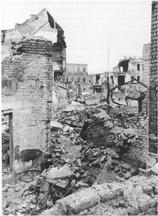
By 1789, the Bavarian Court and State Library opened to the public, well ahead of most other libraries in Europe. Visitors to the library from outside Germany grew in number as well. A large part of the Library’s stock came from around 150 Southern German monasteries and seminaries with collections dating back a thousand years or more, half of which had been acquired during secularization under Napoleon.
The library, in ruins above, also contained manuscripts and incunabula out of the library of Hartmann Schedel, one of the most important humanistic private libraries north of the alps. On the night of March 9, 1943, an incendiary Judeo-Allied bombing attack hit the library, incinerating half a million volumes: a full one quarter of the entire library, including what had been the world’s largest Bible collection. The losses would have been far greater had not the director of the manuscript collection distributed 1,400 large wooden crates of books and other treasures to safer places.
Jewish Bombing of Germany II/II – Wildlife, Farm and Zoo Animals
Note: Whatever your thoughts on zoos may be, the jewish (Lindemann et al) policy of mass murdering German civilians with bombing campaigns extended itself to domestic pets, wildlife, farm and zoo animals as well. The following is gruesome, knowing that these innocent animals were additional victims of judaic bloodlust. This is yet one more example for proving the need to completely remove any jewish influence from this world forever. Also at the end of this article is the topic of potential weather modification occurring just as WW2 began.
HOLOCAUST: A “burnt offering” [holocaust] is a type of korban (sacrifice), specifically an animal sacrifice [goyim = cattle = Germans] in which the entire sacrifice is consumed totally by fire.
The bombing toll on domestic pets and farm animals is never spoken of, but it was a slaughter of momentous proportion. For zoos it was hellish. Zoo animals were bombed or later slaughtered and plundered at war’s end. The few survivors starved or died of cold.
Starving Germans
The judeo-allied bombing toll on domestic pets and farm animals is never spoken of, but it was a slaughter of momentous proportions. Horses burned alive at various stud farms or were simply let loose, cattle were blown to pieces, sheep literally cooked in the fields and thousands of pets were lost, lamed, blinded, orphaned and even eaten out of desperation. For zoos it was hellish. Zoo animals were bombed or later slaughtered and plundered at war’s end. The few survivors starved or died of cold.
Famous animal trainer, Otto Sailer-Jackson ran the Dresden Zoo watched in horror as a wave of bombing set the zoo ablaze:
“The elephants gave spine-chilling screams. Their house was still standing but an explosive bomb of terrific force had landed behind it, lifted the dome of the house, turned it round, and put it back on again… The baby cow elephant was lying in the moat on her back with her legs helplessly reaching up toward the sky, suffering severe stomach injuries unable to move. The hippopotamuses were drowned when debris pinned them to the bottom of their water basin. In the ape house, a gibbon reached out to the trainer, only bloody stumps left of its arms. Nearly forty rhesus monkeys escaped to the trees but were dead by the next day from drinking water polluted by the incendiary chemicals. The next day, a U.S. aircraft pilot flew in low, firing at anything he could see that was still alive… In this way, our last giraffe met her death. Many stags and other animals which we had saved became victims of this hero.”
The Munich Hellabrunn was likewise attacked and nearly destroyed. Adji, the first African elephant born here died in a 1943 American bombing along with several other animals. The Hamm Zoo was victim in 1944, and the Tiergarten Nürnberg lost almost all buildings and enclosures and many of its animals died. The Zoologischen Garten Dusseldorf was bombed repeatedly and completely destroyed November 2, 1944 with over 200 bomb craters to bear witness.
Some of the murdered animals were endangered, and had traditionally been studied, housed and bred in these zoos. The Schomburgk’s deer may once have occurred as far north as China and Laos, but thrived with certainty in south-central Thailand. Now considered extinct, a handful of these deer had been kept in captivity and in 1870, the Hamburg Zoological Garden was the first zoo to actually breed these animals. None survived in captivity and the Hamburg zoo did not survive the war.
Many zoo animals were frantically moved to zoos authorities believed were in safer locations. The zoo inWuppertal, although only slightly damaged by judeo-allied bombing, had no choice but to order their starving animals either shot or sent to other zoos, notably their emaciated lions.
Dead animals in the streets of Berlin
The wonderful old zoo at Frankfurt, first planned in 1859, was another senseless casualty and was destroyed in a single night on March 18, 1944. All buildings except the bear castle were bombed to the cellar. High-explosive bombs smashed the seal pools, the aquarium and the office housing all of the historic archives. In the burning carnivore house, the cats had to be shot, as did an elephant who had been directly hit by an incendiary bomb. Only 20 larger exotic animals survived.
In turn, Wisents evacuated from Frankfurt were killed later when their new home at the Heidelberg Zoo was needlessly bombed at the tail-end of the jewish war in March 1945.
Europe’s bison and largest land mammal is the Wisent. The last wild bison in East Prussia was killed by poachers in 1755. Some were alive in Poland until the First Jewish World War devastated Europe. The last Polish bison reportedly died in 1921, and yet still there were stragglers elsewhere, and at an International Conservation Congress in Paris in 1923, zoologists argued for the conservation of this European bison. Zoologists Heinz and Lutz Heck led a tough fight for the survival of the species by attempting to breed them in captivity in zoos.
Dr. Kurt Priemel of the Frankfurt zoo listened and the International Society for the Conservation of the European Bison was founded. For the first time in zoo history it was realized that zoos can preserve species by cooperation. There were soon 56 pure-blood animals held in zoos and of those, 22 breeding. They slowly but surely multiplied until World War Jew broke out and again decimated their numbers, while at the same time, the last wild ones were poached for food. After the jewish war, 98 pure bred bison reportedly remained worldwide.
Only now are they recovering from the ravages of the jewish instigated war. Today, more than 1,800 bison survive in the wild, spread across Poland, Belarus, Russia, Lithuania and Ukraine. Nearly 1,200 animals are kept in breeding and show cages and zoos. Poland and Germany have led the rescue effort.
Berlin Zoo before the jewish war
In 1939, the gorgeous Berlin Zoo kept over 4,000 mammals and over 1,400 species of birds. Their famous elephant house was totally destroyed by a judeo-allied bombing on November 22, 1943. Before the first bombs fell, however, a bull had escaped from his open pen and began pacing back and forth trumpeting his impending doom. He had to be shot. Not satisfied with one dead elephant, a few days later, on November 26-27, the Yiddish-British struck again and Blockbuster bombs resulted in the escape of several large and potentially dangerous animals: leopards, panthers, jaguars and apes.
They grew frantic. Monkeys found themselves trapped in burning treetops, stunned lions ambled through parks, and large snakes slithered through the crowds of desperate people fleeing fires and bombs. The animals had to be hunted and shot in the streets during and after the bombing raids in the midst of this Armageddon.
Out of 3,715 animals representing 1,400 species living at the grand old Berlin Zoo, only 91 animals remained alive by war’s end.
Bomb damage to zoological collections was astronomic as well. Part of Berlin’s Humboldt-Universität was the Museum für Naturkunde, the first national museum in the world, with a massive collection of more than 25 million zoological, paleontological, and mineralogical specimens, including the largest mounted dinosaur in the world and the best preserved specimen of the earliest known bird. Established in 1810, its priceless collections contain objects from three major fields, paleontology, mineralogy, and zoology. The priceless mineral collections represented 75% of the minerals in the world and attracted researchers from around the world. The collections were horribly damaged by the Judeo-Allied bombing of Berlin and much of the rest was then lost to plunder.
The oldest public Zoo in the world is at the Tiergarten Schönbrunn in Vienna. Even before 1570, there was a wild park in Vienna, and during the reign of Maria Theresia, the Menagerie Schönbrunn was improved substantially, eventually opening to the public, to “decently dressed persons.” In 1778, the menagerie, castle and the park, opened initially on Sundays only. Under Emperor Franz II/I, Schönbrunn received its first giraffe as a gift from the Viceroy of Egypt in 1828.
World War I food shortages had reduced the zoo population 85% to only 400 animals, but with hard work, the zoo was brought back to life. Then, seven weeks before the end of World War Jew, 300 bombs hit the zoo and Castle Park, 200 of them in animal enclosures, murdering many animals, including a beloved rhino bull who used to allow his keeper to ride on his back. Consequent judeo aerial bombing attacks destroyed most of the zoo. Of 3,500 animals only 1,500 lived.
The First jewish World War had also been difficult in Germany as well, and the hunger blockades inflicted by Britain brought most German zoos to the verge of bankruptcy. Most of the Hamburg Zoo’s monkeys, for example, starved to death by the war’s end, as did most animals dependent on either fresh fish or exotic fruits. Two chimpanzees survived the war, only to be lost to the influenza epidemic at the end of the war. Several zoo animals were eaten by a starving civilian population.
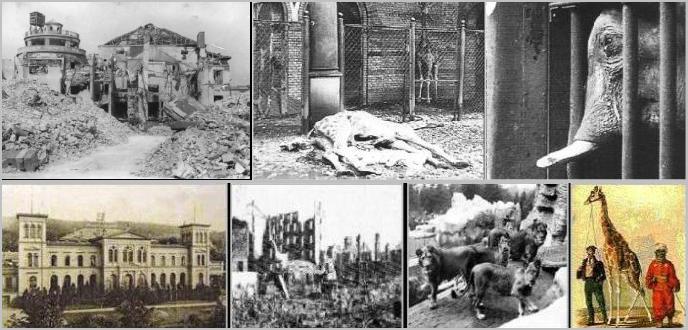
Top row: Berlin Zoo 1945.
Bottom row: Wuppertal Zoo; Frankfurt Zoo bombed;
Starving cats; The first giraffe in Vienna
The Tierpark Hagenbeck is a private zoo in Hamburg which began in 1863 by Carl Hagenbeck Sr., a fish seller and amateur animal collector. The park itself was the first zoo to use open enclosures surrounded by moats, rather than barred cages, to better approximate animals’ natural environments. During World War One, many of the keepers were drafted into the army and some of Hagenbeck’s animals were rented out for use as draught animals for hauling coal and wood on home deliveries. It was not unusual to see elephants and trained bears yoked to heavy wagons as draft animals. The zoo closed for two years after the war as Germany entered into a deep depression, then reopened and improved, bringing in visitors from around the world. Then came the jewish bombing of Hamburg.
On July 24, 1943 Judeo-Allied air raids destroyed three quarters of the zoo in 90 minutes, killing 9 men and 450 animals. From “Animals Are My Life,” by Lorenz Hagenbeck:
“The worst part of it, however, was the fire, which was now quite beyond control. When the first incendiaries came down on the roof of the elephant house and this burst into flames, our resourceful chief keeper, Fritz Theisinger, quickly loosed his fourteen elephants, which he had kept tethered by only one hind leg, and led them outside. There they could try to avoid the incendiaries which were falling everywhere, and they took refuge in the large pool. Next, aided by the Czech P.O.W.s, he made an attempt to save the house, but at this point the P.O.W.s lost their nerve and ran away.”
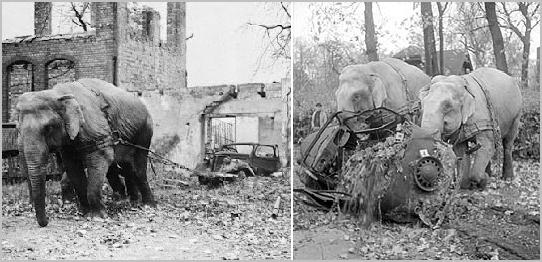
Hamburg zoo animals put to use after the war.
Wildlife
There appears to be a scientific aversion to study the effects of the massive campaign of aerial bombing on life forms in general and an avoidance of the subject. The North Sea ‘Houtings’ were fish found in the Rhine, Meuse and Scheldt rivers (Coregonus maraena) which are now considered globally extinct, the last individual being caught in the lower Rhine in the early 1940s before the massive bombing attacks devastated its environment. In fact, much of the vast ecological disaster created by the Judeo-Allied bombs has not received the scrutiny it deserves. One only has to look at what took place in Helgoland to realize the extent of destruction.
Helgoland (Heligoland) is on a major migration route for birds crossing the North Sea, and in the early 19th century became a source of bird specimens for collectors and museums. Ornithologist and artist Heinrich Gätke moved to the island in 1841 and remained there for the next sixty years studying the birds and collecting rare specimens for both artists and scientists. He coined the term “Vogelwarte” and produced the book “Die Vogelwarte Helgoland” based on his research. A modern observatory was established in 1910 by Hugo Weigold with a systematic trapping and banding program using the “Heligoland traps” he developed. There is no question that most species of migratory and native birds on Helgoland must have been drastically affected by the cataclysmic bombing of the habitat, but little is written on the subject.
Also: Helgoland Island: With two waves of bombing raids on 18 and 19 April 1945, 1,000 Allied aircraft dropped about 7,000 bombs on the islands, this being one of two massive bombings of the island.
Then, after the war.
The explosion used 7400 tons (6700 metric tons) of surplus World War II ammunition, which was placed in various locations around the island and detonated at 1 p.m. on 18 April 1947 by the Royal Navy.
And nobody today has probably ever heard of the Entomological Society of Stettin, or indeed, of “Stettin” itself, which has been recreated as being historically Polish and redubbed “Szczecin.” Stettin was the historical capital of the Prussian province of Pomerania, which was German for almost all of modern history and stretched almost to Danzig. This stately and intellectual city was the residence of the dukes of Pomerania and once an important member of the Hanseatic League. Based here was the Entomological Society of Stettin (Entomologischer Verein zu Stettin) formed in 1839 and the leading entomological society of the 19th century. Most German entomologists were members, as were many from England, Sweden, Italy, France, and Spain.
The society had vast, extensive collections and a very comprehensive library, all of which were destroyed by bombing and looting as the city and area suddenly became “ancestral Polish lands” and stolen by the communists. Yet, one hears nary a reproach for the scientific loss to the world.
Geoengineering?
In other areas, however, scientists are starting to look back at the effects of war on the earth, its creatures and our climate. Rob MacKenzie led a recent study at the Lancaster Environment Centre in the United Kingdom on the contrails created by Judeo-Allied bombing runs and their effect on the weather. The researchers found that the contrails from these aircraft significantly suppressed the morning temperature increase across areas with a high density of flights since they have complex effects on the Earth’s surface temperature.
“This is tantalizing evidence that Second World War bombing raids can be used to help us understand processes affecting contemporary climate,” MacKenzie said.
Other scientists discuss depth charges and naval warfare’s effect on weather: The winter of 1939/40 brought sudden and unexpected arctic conditions from Southern England to Stockholm. A.J. Drummond, a scientist from Kew Observatory at Richmond, expressed surprise at this unusual phenomenon in 1943 when he wrote:
“The present century has been marked by such a wide-spread tendency towards mild winters that the ‘old-fashioned winters,’ of which one has heard so much, seemed to have disappeared forever. The sudden arrival at the end of 1939 of what was considered to be the beginning of a series of cold winters was therefore all the more surprising. Since the winters of 1878-79, 1879-80 and 1880-81, there have never been such severe winters, three in succession, as those of 1939-40, 1940-41 and 1941-42.”
From Arnd Bernaert’s ‘Climate Change & Naval War – A Scientific Assessment.’
[The book seeks to demonstrate that the industrialized world contributed to at least two significant climatic changes during the 20th century, viz. WWI and WWII. This became particularly obvious when an arctic winter befell Northern Europe only four months after World War II had started, ending a pronounced temperature rise all over the Northern Hemisphere which had started with the end of WWI in 1918. The ‘Big Warming’ in 1918 started at the Norwegian Island Spitsbergen high in the North bordering the Arctic Sea. Not far away a devastating naval war had been deterred for four years. Winters since 1918 were the warmest for several hundred years. The expression ‘Greening of Greenland’ and ‘Warming of Europe’ were established. Suddenly, exactly two decades after WWI the trend was reversed.]
Source: http://www.renegadetribune.com/jewish-bombing-of-germany-ii-ii-wildlife-farm-and-zoo-animals/









